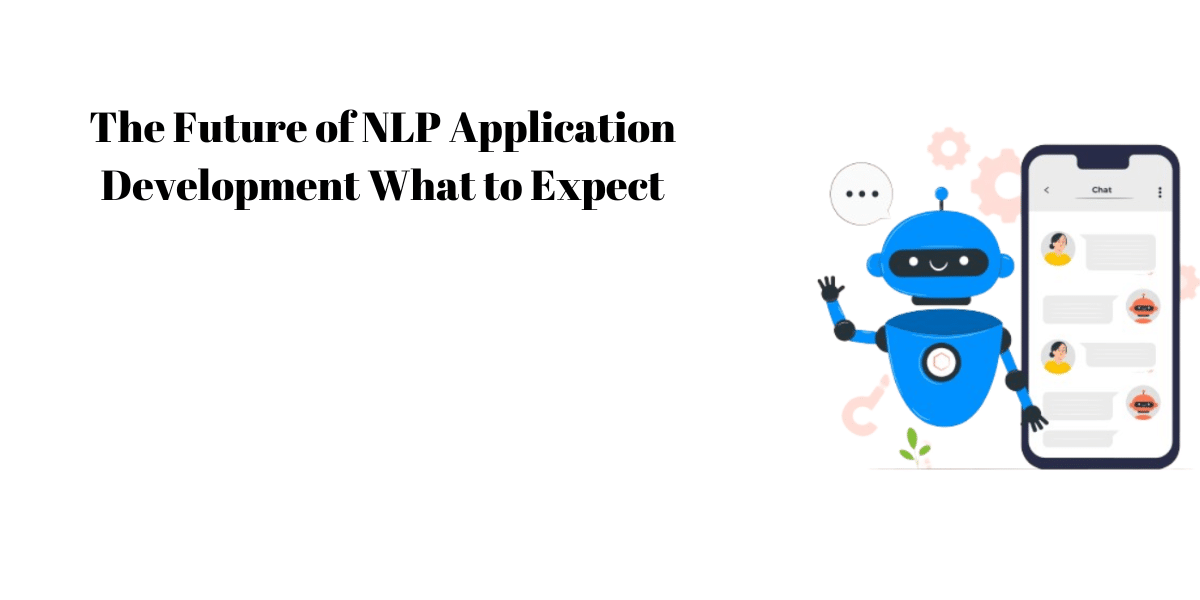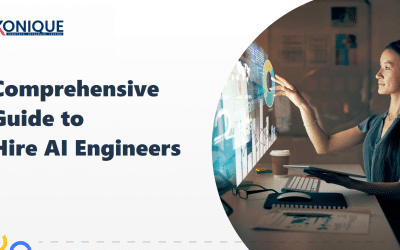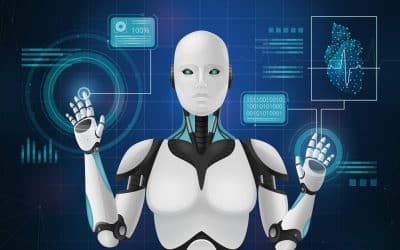With the constantly evolving technological landscape, the technology of the future for NLP application development is a source of great potential and excitement. We are at the end of the road to innovation. Considering the future of NLP, it is evident that the combination of artificial intelligence (AI) services for development and NLP capabilities will lead to revolutionary changes across all sectors.
NLP is a subset of artificial Intelligence that enables machines to interpret and understand human language using a method similar to the human mind. Its applications span various fields, including virtual assistants, sentiment analysis, language translation, and content summaries. What lies in the future for NLP isn’t just the expansion of existing capabilities but an enlightening transformation driven by advances in AI advancement services.
Incorporating AI development capabilities in NLP frameworks marks a new age of precision and effectiveness. By combining machine neural networks, learning algorithms, and deep-learning techniques, NLP systems are poised to reach new levels of precision, context understanding, and flexibility.
One significant factor that will determine the direction of NLP apps is the search to develop contextual Intelligence. AI development tools are set to boost NLP algorithms’ capacity to discern nuanced meanings, recognize idiomatic words, and recognize subtle clues to context in conversation and textual information.
Additionally, the convergence of NLP and AI development capabilities is anticipated to change how humans interact with machines. Chatbots that are intuitive and capable of mimicking human-like conversation to personalized content recommendation systems and more, the next generation of NLP applications is expected to offer effortless integration of technologies in everyday living.
The Future of NLP Applications: What to Expect in Natural Language Processing Development
This article examines the significant developments and the future of Natural Language Processing development, providing insight into the possible impacts for diverse sectors.
Enhanced Language Understanding
The core for NLP applications is understanding language And, shortly, the promise of unprecedented advances in this field. Through the integration of deep learning methods, neural networks are becoming better and more efficient, allowing machines to recognize the context, tone, and emotions embedded into the human spoken language. This increased comprehension will lead to more accurate and contextually-aware NLP applications.
Conversational AI and Chatbots
The emergence of conversations using AI and chatbots will continue to transform the customer experience, business communications, and individual assistance. Future NLP applications will have sophisticated chatbots capable of engaging in natural conversations that are contextually aware. The chatbots will not only comprehend the user’s queries but also anticipate and address the needs of users proactively, resulting in a unique interaction experience.
Multilingual and Cross-Lingual NLP
NLP can break down language barriers by advancing algorithms that can comprehend and process different languages simultaneously. The next phase of NLP is expected to see a rise in cross-lingual and multilingual apps, facilitating international communications and information exchange. This development is essential for organizations and businesses operating across diverse languages.
Explainable AI for Transparency
The need for clarity and interpretability increases as NLP applications are integrated into decisions. In the future, NLP models will focus on Explainability, allowing people to grasp the logic behind AI-driven choices. This is essential for creating trust and ensuring the safety of AI implementations, specifically in sensitive fields like finance and healthcare.
Emphasis on Ethical and Bias-Free NLP
Ethics and ethical issues surrounding NLP advancement are becoming more prominent. Addressing biases within language models and ensuring fairness within NLP applications will soon be essential concerns. Researchers will strive to create impartial datasets, implement algorithms to reduce biases and encourage fairness and inclusion within NLP techniques.
Integration with other Technology
The future for NLP goes beyond understanding language and seamless integration with other advanced technology. Natural Language Processing will converge with virtual reality, augmented reality, and the Internet of Things (IoT) and create truly rich experiences. Voice-activated commands, for instance, could be used to control devices, and AR apps could offer instantaneous translation of language.
Personalized User Experiences
NLP application solutions will be developed to deliver highly customized user experiences tailored to the individual, adjusting experiences and content per your preferences and habits. The level of customization can not only increase users’ satisfaction, but will can also improve overall efficiency of NLP applications across a variety of domains such as education, e-commerce and more.
Advancements in NLP for Healthcare
The health sector will significantly benefit from NLP advancement in the coming years. Future applications will successfully gain valuable information from medical documents, help diagnose, and aid in communication between doctors and patients. The role of NLP in healthcare is expanding to include the discovery of drugs, analysis of research, and improvement of the medical profession.
Continuous Learning and Adaptation
NLP models will be more proficient in continuous learning and adapting to changing language patterns and user behavior. This ability to adapt ensures that NLP apps remain useful and efficient in the long run, which makes NLP models valuable for companies and individuals working in constantly changing environments.
Security and Privacy Considerations
As we continue to integrate NLP in various areas of our daily lives, Privacy and security concerns are becoming major concerns. In the future, NLP innovations will emphasize strong security measures, such as the use of complete and secure encryption to protect sensitive data and guarantee trust for users.
Key Features of Natural Language Processing Development
As NLP continues to develop due to advances in artificial Intelligence and machine learning, many fundamental characteristics characterize its evolution and influence its effects on society and businesses.
Semantic Understanding
It is a critical aspect of NLP advancement: its capacity to grasp the meaning of human spoken language. With techniques such as embedding words and deep learning models, NLP systems can interpret the context of a word, deduce the relationships between words, and understand the subtleties of human conversation. Semantic understanding allows NLP to draw insight from unstructured textual data, which can assist in tasks like the analysis of sentiment, recognition of entities, and document summarization.
Language Adaptability
NLP development strives towards agnosticism in language, comprehending and processing diverse dialects and languages with the same competence. Multilingual NLP models employ transfer learning methods to expand understanding across languages, providing seamless capabilities for processing languages. It is vital to accommodate language for multinational businesses and multilingual societies. It allows NLP models to accommodate different needs in linguistic and cultural situations.
Contextual Awareness
Context is a key element in understanding language and influences the interpretation and meaning of texts. NLP research focuses on context awareness using techniques like Attention mechanisms and transformer architectures that allow models to recognize context-specific nuances and long-range dependencies in texts. Contextual understanding allows NLP systems to detect confusion, identify homonyms and ambiguities, and provide contextually relevant answers to conversations.
Continuous Learning
The dynamic nature of languages requires continuous adaptation and learning within NLP models. Incremental learning techniques allow NLP models to take in new patterns in linguistics, adapt to changing usage patterns, and incorporate knowledge specific to the domain as time passes. Continuous learning enables NLP models to be current in ever-changing contexts, improve their knowledge of semantics in language, and limit concept drift in the long run.
Interpretability and Explainability
In letting NLP applications penetrate critical domains, including finance, healthcare, and law, the ability to interpret and justify models becomes essential. NLP advancements focus on techniques for modeling introspection that allow people to better understand how NLP models arrive at choices and conclusions. Frameworks for interpretability, such as saliency maps and attention visualization, offer insights into how models behave that help to build confidence, accountability, and compliance with regulatory requirements in NLP deployments.
Ethics and Bias Mitigation
Eliminating biases and ethical concerns that arise from languages and NLP models is essential to ensuring moral NLP development. Strategies for detecting biases, as well as mitigation and fairness testing, are designed to detect and eliminate biases from models and training data to ensure equitable treatment of all groups of people. Frameworks and guidelines for ethical conduct promote transparency, inclusion, and ethical decisions in NLP practice while integrating technology with social values and ethical guidelines.
Scalability and Efficiency
With the growing massive data and real-time text stream, scalability, and effectiveness are crucial aspects of NLP development. Scalable structures, distributed computing frameworks, and optimized algorithms permit NLP platforms to process vast text information without much latency or service cost. The ability to scale ensures that NLP solutions can handle the increasing volume of data and users and support mission-critical applications within enterprises and online platforms.
Integration and Deployment
Integration and deployment pipelines speed up the use of NLP solutions by organizations and software ecosystems. NLP development frameworks and libraries provide APIs, SDKs, and trained models that allow the integration of the existing workflows and software infrastructure. Containerization and cloud-native technologies allow for scalable and on-demand delivery of NLP services in distributed environments. This improves the ability to scale, agility, and interoperability during production deployments.
User-centric Design
Human-centered design principles are the foundation of NLP development by focusing on accessibility, user experience, and usability in NLP applications. Methodologies for designing with a focus on users, feedback loops, and tests for usability ensure that NLP interfaces are easy to use, responsive, and accessible for various demographics. Natural Language Processing companies invest in research for users and interface design to provide enjoyable, intuitive experiences that allow users to communicate with NLP systems efficiently and effectively.
Safety and Security
Security and Privacy: Protecting confidential information and ensuring users’ Privacy are top priorities in NLP development. Robust security protocols, encryption methods, and access control mechanisms reduce the risk of data breaches and unauthorized access to NLP systems and textual data. Techniques to protect Privacy, like differential Privacy or Federated Learning, ensure users’ confidentiality and allow the sharing of NLP model training across dispersed data sets and boundaries within organizations.
Conclusion
The future of NLP applications is highly hopeful, potentially transforming different industries and domains. With the advancement of technology, NLP applications are expected to be more sophisticated, efficient, and seamlessly integrated into our lives. Through the constant refinement of algorithms, the growth of data sets, and the advancement of even more powerful computing infrastructures, NLP is expected to surpass its current capabilities.
There is potential for a boom in NLP applications that span a range of industries, including finance, healthcare and education, customer service, and others. The applications will enable greater human-computer interaction that is more intuitive, speed up information processing, and provide more detailed insights using unstructured sources of data.
Furthermore, as the understanding of natural languages is more complex and context-cognizant, NLP applications will be better able to deal with confusion, dialectic expressions, and multilingual communications, accommodating the ever-changing world.
Yet, problems such as privacy-related concerns, ethics, and data biases are important and should be addressed actively to ensure the responsible and fair use of NLP technology.












